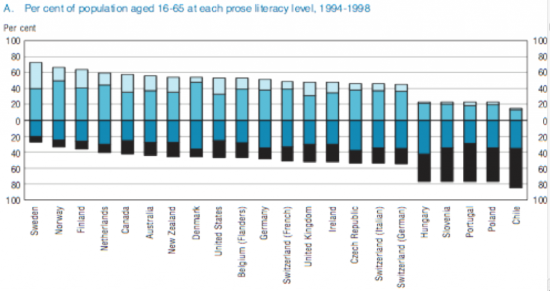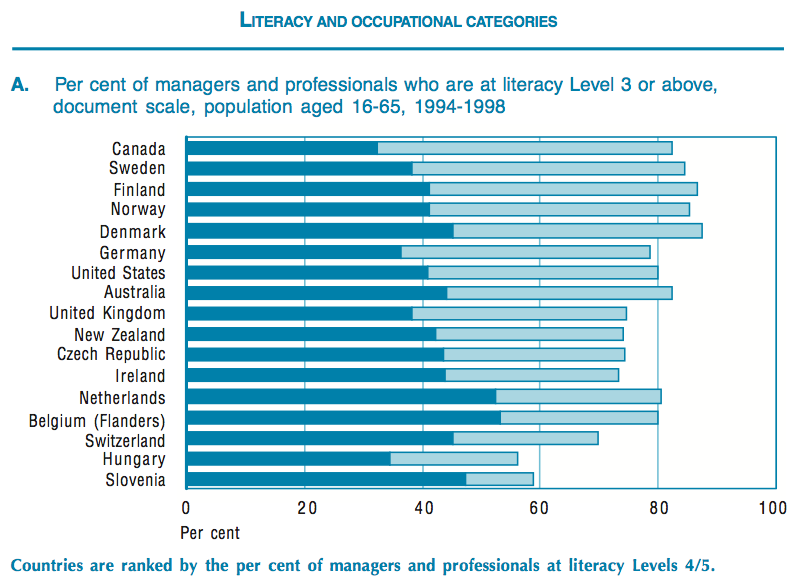8% of adults have ‘a severe literacy deficit’
A “severe literacy deficit” haunts the world’s most developed countries. Between one-quarter and three-quarters of the world’s adults don’t have a “suitable minimum skill level” for coping with the demands of modern life and work.

That’s according to the International Adult Literacy Survey, a large-scale cooperative effort by governments, national statistical agencies, research institutions and the Organisation for Economic Co-operation and Development.
The study included 20 countries, representing more than 50% of the world’s gross domestic product.
Three types of literacy
The study rates three types of literacy on a 500-point scale:
- Prose literacy — the ability to understand and use information from linear copy, like editorials, news stories, brochures and instruction manuals. Average score across countries: 221 points (Level 1 of 5) to 301 points (Level 3).
- Document literacy — the ability to locate and use information in nonlinear documents, including job applications, payroll forms, transportation schedules, maps, tables and charts. Average score across countries: 219 points (Level 1) to 306 points (Level 3).
- Quantitative literacy — the ability to use numbers in printed materials. Tasks include balancing a checkbook, figuring out a tip, completing an order form or determining the amount of interest on a loan. Average score across countries: 209 points (Level 1) to 306 points (Level 3).
The results?
In 14 out of 20 countries, at least 15% of all adults have only rudimentary literacy skills, researchers say, making it hard for them to cope with the rising skill demands of the information age.
A world of pain
Prose literacy rates in 20 developed countries

Vincente can’t read Sweden ranks highest and Chile lowest among 20 countries in prose literacy, or how well people can use linear text like articles. But all of these developed nations face a ‘literary skills deficit.’ Source: Organisation For Economic Co-Operation And Development’s ‘Final Report Of the International Adult Literacy Survey’
Lowest literacy levels. Chile had the lowest average on all three scales. But it’s not alone. Countries with more than 15% of people at the lowest levels of prose literacy include:
- Australia
- Belgium (Flanders)
- Canada
- Chile
- Czech Republic
- Hungary
- Ireland
- New Zealand
- Poland
- Portugal
- Slovenia
- Switzerland
- The United Kingdom
- The United States
Highest literacy levels. Sweden had the highest average on all three scales. All told, six countries have fewer than 15% of adults at the lowest level of prose literacy skills:
- Denmark
- Finland
- Germany
- The Netherlands
- Norway
- Sweden
But wipe that smirk off your face, Sweden. Even there, in the most literate country in the study, 8% of adults have “a severe literacy deficit.”
Five levels of literacy
The study divides each type of literacy into five levels:
Level 1: very poor. A person with Level 1 literacy, for instance, might not be able to figure out how much medicine to take based on information printed on the package.
Level 2: weak. These folks may have developed coping skills to manage everyday literacy demands. But their low literacy level makes it hard for them to face new demands, such as learning new job skills.
Level 3: basic. These folks have achieved a “suitable minimum” of literacy for coping with the demands of everyday life and work. This is about the skill level required to finish secondary school and get into college.
Levels 4 and 5: good to excellent. These folks have high information-processing skills.
“Even the most economically advanced societies have a literacy skills deficit,” researchers say. “Between one-quarter and three-quarters of adults fail to attain literacy Level 3, considered by experts as a suitable minimum skill level for coping with the demands of modern life and work.”
What can people at different literacy levels do?
Level 1 (0-225)
- Prose: Find the “maximum number of days you should take this medicine” on a label that includes the heading “Dosage” and the phrase “not longer than 7 days”
- Document: Identify from a chart the percentage of teachers from Greece who are women
- Quantitative: Add $50 + $2 on an order form
Level 2 (226-275)
- Prose: Determine what happens when a plant is exposed to temperatures of 14°C or lower in an article with the sentence “When the plant is exposed to temperatures of 12-14°C, it loses its leaves and won’t bloom any more”
- Document: Identify from a chart the year in which the fewest people were injured by fireworks in the Netherlands
- Quantitative:Determine how many degrees warmer today’s high temperature is expected to be in Bangkok than in Seoul using a weather chart in a newspaper
Level 3 (276-325)
- Prose: Figure out how to ensure that a bike seat is in the proper position by reading a page from a bicycle owner’s manual
- Document: Write a brief description of the relationship between sales and injuries based on the information shown in the two graphs
- Quantitative: Add three numbers from two charts to calculate the total amount of energ consumed by Canada, Mexico and the United States
Level 4 (326-375)
- Prose: Write in your own words the difference between a panel and group interview, based on a pamphlet about hiring interviews
- Document: Summarize how oil use changed between 1970 and 1989, based on two pie charts
- Quantitative: Calculate how much money you’d have if you invested $100 at a rate of 6 per cent for 10 years
Level 5 (376-500)
- Prose: List two ways an employee support initiative helps people who lose their jobs in a departmental reorganization, based on an announcement from the personnel department
- Document: Determine the average advertised price for the “basic” clock radio receiving the highest overall score on a page taken from a consumer magazine rating clock radios
- Quantitative: Calculate the total number of kilometers traveled on a trip from Guadalajara to Tecomán and then to Zamora using a distance chart
A world of pain
Prose literacy rates in 20 developed countries

Source: Organisation For Economic Co-Operation And Development’s ‘Final Report Of the International Adult Literacy Survey’ OECD, 2000

Leave a Reply